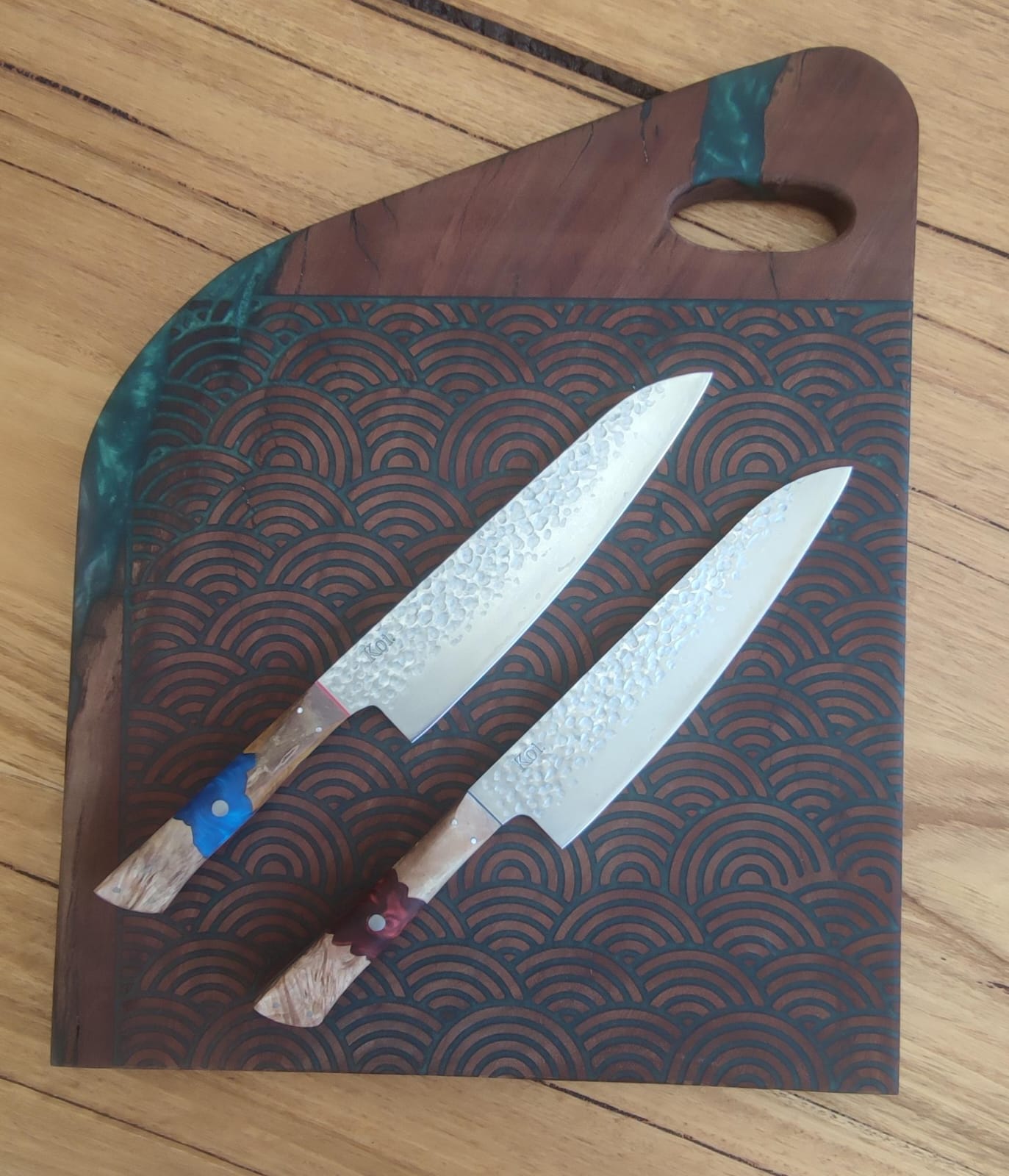The last touches applied to the blade's surface, known as blade finishes, give a knife its identity and excellent looks. These aesthetics result from the skilful blending of various materials, impressions, light reflections, and geometric shapes.
They also serve as a tribute to the skill of blacksmiths and sharpeners. It is a blacksmith's distinctive style and personal stamp. Knife enthusiasts typically can identify a knife's blacksmith collection just by the blade finish.
A knife’s performance is not significantly affected by the visual variances in these coatings. However, specific finishes offer superior performance or make it simple for food to be brushed off the blade.
When buying a knife, the blade finish can offer several advantages. Here's a quick guide to understanding what each blade finish offers and how it can add strength and durability or improve the knife's appearance.
Hand Satin Finish
Sanding the blade by hand with progressively finer abrasives in one direction results in a satin finish. A satin finish accentuates the bevel of the blade while eliminating reflected reverberation.
A hand satin is done on high-end blades—the more even the line, the smoother the abrasive. Satin finishes can also be utilised to improve the aesthetic of the knife's handle or fasteners.
A lovely satin hand finish takes time and raises the price of the knife.
Brushed Finish
An abrasive art is used to produce a satin finish pattern in a brushed finish. Overall, it provides an appealing work finish without the expense of a hand satin finish. These gorgeous patterns are comparable to the cool-looking Damascus steel-patterned knives you'd want to use all the time!
A brushed finish can be combined with appliques in a hand satin finish blade.
Mirror Polished Appearance
The process of hand polishing metal to achieve mirror-polished quality results in a highly reflecting surface. Although it looks great and provides higher corrosion resistance thanks to the smoothness of the blade, this sort of finish necessitates a lot of polishing to keep its brilliant and shiny appearance.
Because of the skill and time necessary to attain this polish, blades and bespoke knives for correctors or exhibition models are sometimes highly costly. A mirror surface is readily damaged when the blade is used, it is frequently employed as an aesthetic finish on high-end knives for collectors.
Migaki blade finish is preferred for softer stainless steel and polished to a near-mirror perfection. These Japanese blades are polished to a brilliant, silky shimmer, although they are not quite mirror-like in appearance.
Blasted Finish
A homogeneous, grey finish is produced by blasting high-pressure materials against the metal like abrasive glass or ceramic beads.
Grain of various sizes and materials is utilised with a compressor and a blasting cannon. Because of the smooth, even surface of the sandblasted finish, reflection and glare are reduced.
A knife blade sandblasted finish is an introductory or user-level finish. The steel is more vulnerable to rust and corrosion as a result of the micro-abrasions caused by the blasting. Even in stainless steel knives, a sanded blade can rust if kept in a moist environment.
Coated Finish
The scorch is often black, flat dark brown, or grey, and the blade is coated to lessen reflection, glare, wear, and corrosion. The blade should be coated periodically because all coatings are susceptible to scratching after prolonged, heavy use.
The tougher the finish, the more excellent its wear resistance and the higher the cost of adding it. Rather than using basic varnish drying paints or chemical burn with liquids, high-quality coatings are electrically, chemically, and thermally attached to the surface.
Kurouchi is a Japanese term for a knife finish that also means "first black or black finish." The layers of iron and steel utilised in forging give the blade its black colour, where the blackened forged steel retains the colour from forging.
Notably, most blades are sandblasted before being coated to provide the best surface for adhesion. By inhibiting corrosion or rust, coatings can increase a blade's lifespan (particularly one made of carbon steel). Quality coatings increase the price of a knife but provide greater corrosion resistance, and need less care.
If you want a less sophisticated knife finish, a dark knife aesthetic, or a rustic-looking blade, the Kuruochi and coated finishes are suitable options. Additionally, military and tactical knives have this type of finish.
Stonewashed Finish
The term "stonewashed finish" describes the process of turning the blade within a container that contains an abrasive substance in the form of cones or stones. This coating offers a less reflecting quality than a brushed or glossy blade and effectively conceals scratches.
Stonewashed finishes come in a broad range depending on several factors, like the stones' abrasive form and rotational movement.
A blade with a "black stonewash" finish has been acid washed to darken it before being stonewashed. By creating a durable oxide barrier between the steel and the environment, acid oxidation increases a blade's resistance to rust.
The stonewashed blades and handles benefit from low maintenance and retain their original appearance for an extended period. The stonewashed finish conceals the scratches that develop with regular use.
Hammered Finish
This finish is applied using a chisel with a tip that has the punching form you want to achieve on the knife—a punch with a round head of a specific size, depending on the desired effect. The hammered finish resembles the Japanese Nashiji, which is made by punching the steel as it is forged.
Blades made of carbon and stainless steel can be designed to have the hammered finish. Japanese kitchen knives are a common choice since they are stylish and useful. Traditionally the hammered finish was to showcase the blacksmiths skills, leaving behind their makers mark with every strike of their hammer.
When slicing and chopping fruits and vegetables, the hammered finish helps keep food from clinging to the blade.
Conclusion
Ultimately, each surface finish offers benefits and drawbacks but is often just a personal preference in appearance.
The blade finish should be selected based on how the knife will be used and what it will be used for since this can assist keep the knife's look or durability.
The knife blade's surface finish affects the knife's overall cost and must correspond to the knife's function. The blade finish is a practical and aesthetically pleasing option when comparing knives.




